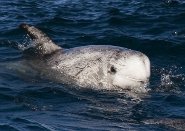 Cuvier was the first person who had described the Risso's Dolphin (Grampus Griseus) in the year 1812. Antoine Risso had described this species to Cuvier after which Cuvier made the first description and thus, the species got its name after Antoine Risso. Risso's Dolphins are also commonly known as grampus. Grampus was previously the common name used for the Orca. From where the word 'grampus' has been derived is not yet clear. It is believed that the word 'grampus' has been probably derived from the French word 'grand poisson' or the Latin word 'grandis piscis' because the meaning of both the words is 'big fish'. The specific nickname 'griseus' means the mottled grey-colored dolphins.
Cuvier was the first person who had described the Risso's Dolphin (Grampus Griseus) in the year 1812. Antoine Risso had described this species to Cuvier after which Cuvier made the first description and thus, the species got its name after Antoine Risso. Risso's Dolphins are also commonly known as grampus. Grampus was previously the common name used for the Orca. From where the word 'grampus' has been derived is not yet clear. It is believed that the word 'grampus' has been probably derived from the French word 'grand poisson' or the Latin word 'grandis piscis' because the meaning of both the words is 'big fish'. The specific nickname 'griseus' means the mottled grey-colored dolphins. The length of Risso's Dolphin is typically 3 m (10 feet) but some dolphins have been recorded as having 3.8 m (12.5 feet) of length. Like most dolphins, males of this species are also larger than females. It is weighed 660 to 1100 lbs (300 to 500 kg) which makes it the largest species known as 'dolphin', while pilot whales and orcas are the actual dolphins and do not derive any such common name.
Risso's Dolphins are found in tropical and temperate waters throughout the world. They do not come near the coast and roost in deep waters. The tropical parts where Risso's are found include Indian, Atlantic, and Pacific oceans.
The population of Risso's Dolphins around the United States is about 60,000. The population in the Eastern Tropical waters of Pacific Ocean is about 175,000 and 85,000 in the Western side. There is no confirmed global estimation of their population.
Risso's Dolphins feed mainly on squid, fish, crustaceans and other cephalopods. Like other dolphins, these dolphins also like to roost in groups. There can be 3 to 50 individuals in one group and sometimes, they even get mixed with other whales and dolphins, and also cetaceans. These groups form long lines while hunting. This species is inclined to ride along with the boats and the juveniles often breach clear water slapping their flippers or raising their heads above the water. They produce various sounds with specific signature whistles. They use most of their sounds to detect their prey.
Risso's Dolphins prefer swimming in warm tropical and temperate waters near shores. The number of individuals in this species is quite abundant and they are found in a wide range. They prefer to live in deep-off-shore waters but sometimes, they are seen on the shores of oceanic islands as well. This species generally does not approach boats. There can be some rare cases but it is against its nature. Whaling of Risso's Dolphin is not that widespread but in Sri Lanka this species is being damaged on a large scale through different operations. Globally, there is no danger to the existence of this species.
p.s. there are larger species of dolphin but they don't have 'dolphin' in their name, for example: killer whale or pilot whale
Picture of the Risso's dolphin by Mike Baird (bairdphotos.com), licensed under Creative Commons Attribution 2.0
The Grey dolphin, risso's dolphin is listed as Data Deficient (DD), inadequate information to make a direct, or indirect, assessment of its risk of extinction, on the IUCN Red List of Threatened Species
Namings for the Risso
A young / baby of a Risso is called a 'calf or pup'. The females are called 'cow' and males 'bull'. A Risso group is called a 'team, school, pod, herd, alliance (male) or party (female)'.Countries
Albania, Anguilla, Antigua and Barbuda, Argentina, Aruba, Australia, Barbados, Belgium, Bermuda, Bosnia and Herzegovina, Brunei, Burma, Cambodia, Canada, Cayman Islands, Chile, China, Costa Rica, Croatia, Denmark, Dominican Republic, Estonia, Finland, France, Germany, Greece, Grenada, Haiti, India, Indonesia, Iran, Iraq, Ireland, Italy, Jamaica, Japan, Jordan, Kenya, Korea, South, Kuwait, Lebanon, Lithuania, Malaysia, Maldives, Malta, Mexico, Namibia, Netherlands, Netherlands Antilles, New Caledonia, New Zealand, Norway, Oman, Pakistan, Palau, Papua New Guinea, Philippines, Poland, Portugal, Puerto Rico, Qatar, Russia, Saint Kitts and Nevis, Saint Lucia, Saint Pierre and Miquelon, Saint Vincent and the Grenadines, Saudi Arabia, Seychelles, Singapore, Slovenia, Solomon Islands, South Africa, Spain, Sri Lanka, Sweden, Syria, Taiwan, Tanzania, Thailand, TimorLeste, Trinidad and Tobago, Turkey, United Arab Emirates, United Kingdom, United States, Vietnam, Virgin Islands and YemenSome facts about the
Risso's dolphin
Adult weight : 425 kg (935 lbs)
Maximum longevity : 43 years
Gestation : 365 days
Litter size : 1

Custom Search